NVIDIA's GeForce GT 430: The Next HTPC King?
by Ryan Smith & Ganesh T S on October 11, 2010 9:00 AM ESTPower, Temperature, & Noise
We only have 1 GT 430 card on hand, so unlike past articles we cannot compile any data on the load voltages of this line of cards. Our lone Asus card has a load voltage of 1.08v, and an idle voltage of 0.88v. Idle clocks are 50.6MHz for the core, and 270MHz effective for the memory.
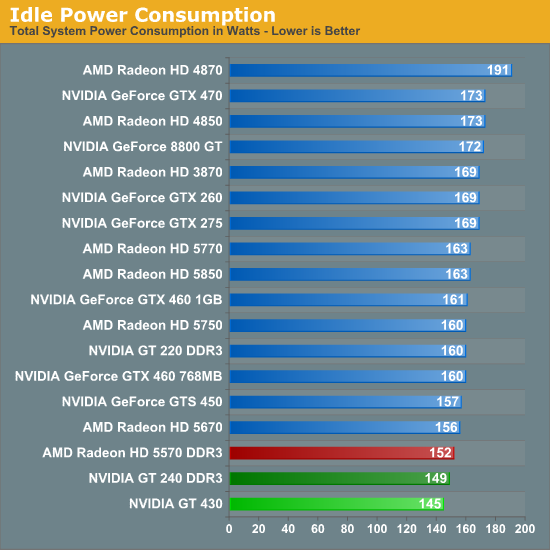
While GT 430 may not be competitive on a performance-per-dollar basis, it’s hard to argue with these power results. Even at these low wattages where our 1200W power supply isn’t very efficient, the GT 430 still delivers an idle power consumption level 7W under the Radeon 5570, and an even larger 11W advantage over the otherwise performance-superior Radeon 5670. We can’t measure the card’s actual power consumption and NVIDIA does not provide a reference level, but the GT 430 can’t be drawing more than a couple of watts here.
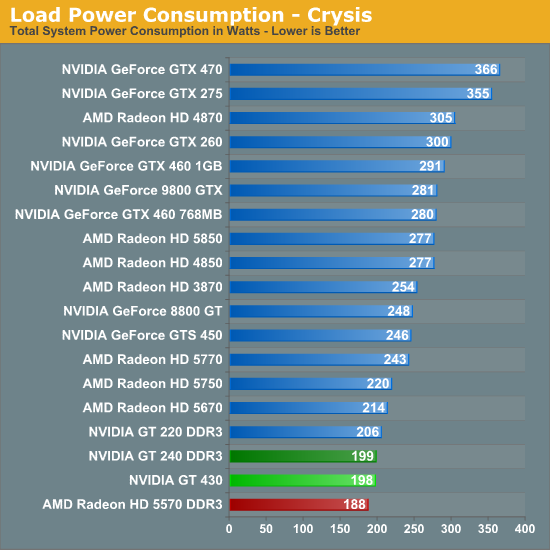
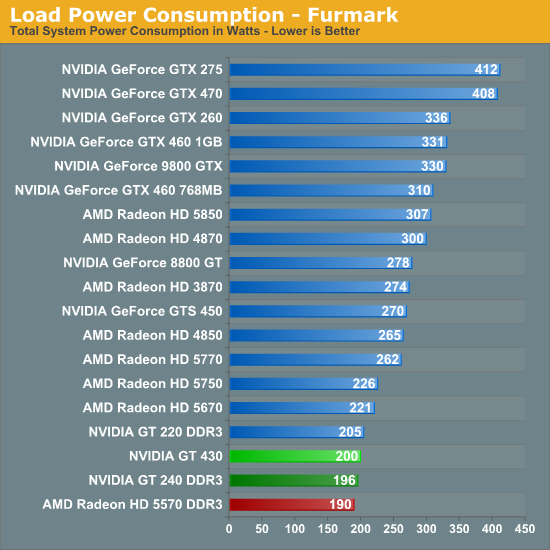
Under load things are less rosy for the GT 430. Under Crysis it ends up drawing 10W over the 5570, which serves as yet another testament to the amazing level of performance-per-watt that AMD has been able to attain; remember that the 5570 had better performance at the same time. Under Furmark the situation is just as bad, but at this point we’re looking at a more pathological case. Overall 10W isn’t going to break the bank in an HTPC (especially since these cards would rarely get up to full clocks in the first place) but it’s something to consider if every watt is going to count.
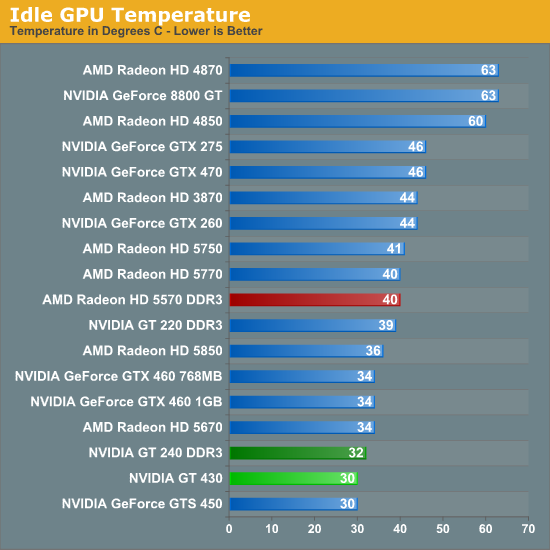
When it comes to idle temperatures, the GT 430 is second to none. With the card only consuming a couple of watts at idle in the first place, its idle temperatures are barely above room temperature (and even closer to ambient case temperatures). It’s tied with the GTS 450, which impressed us last month with its highly capable cooler. Meanwhile our 5570, which is a low-profile card just like the GT 430, ends up being a good 10C higher. AMD’s higher idle power consumption directly translates to a higher idle temperature.
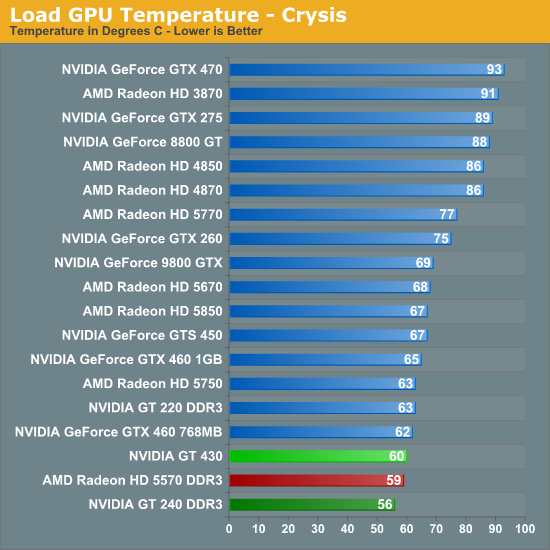
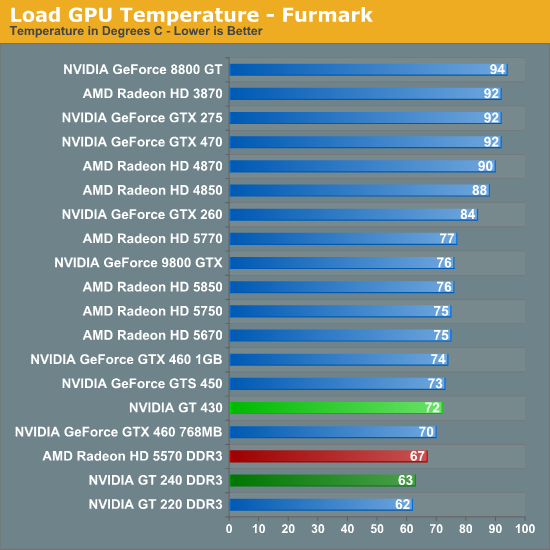
Looking at load temperatures, these results aren’t all that surprising given the cooler in use. The Asus cooler is practically a passive cooler, as the small fan is not capable of moving much air (though it is unusual to not see Asus aggressive on cooling). As a result it manages to reach higher temperatures, but we’re still only talking about 60C under Crysis and 72C under Furmark. This is worse than the 5570 and its larger fan by a bit, but not significantly so.
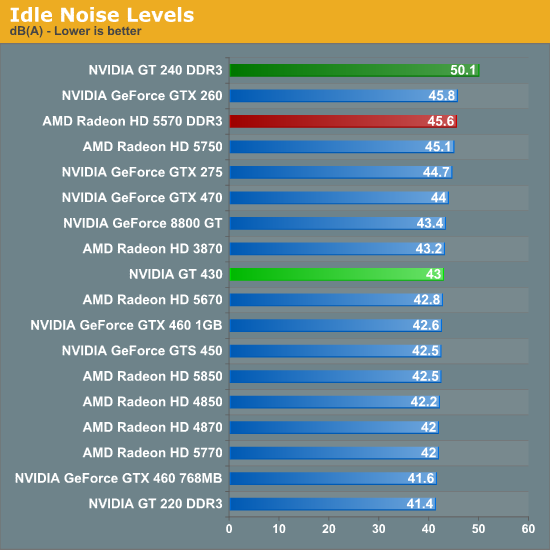
At idle the GT 430 is consistent with our other cards. With the exception of a couple ridiculous cards like our GT 240 and in this case the 5570, everything is at roughly 42-44dB(A). The 5570 is more fan than heatsink, which is likely why it has such a poor showing here compared to the GT 430.
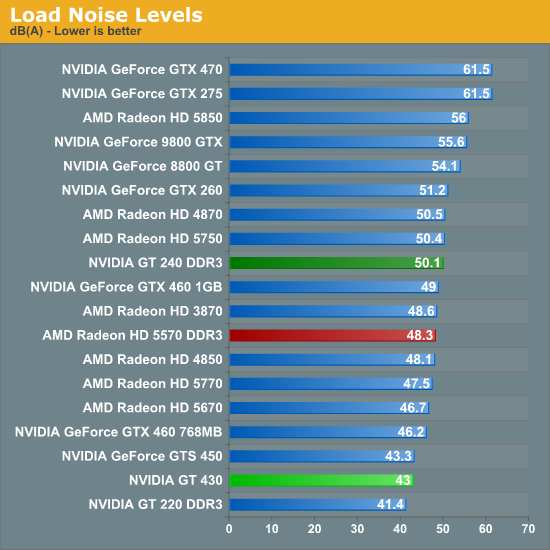
The payoff of accepting higher temperatures is less noise to contend with. The GT 430 never needs to ramp up its fan in our tests, delivering a load noise level even lower than the GTS 450, and only worse than a GT 220 that runs up against ambient noise levels. If you want to make a good HTPC card then it needs to be silent, and Asus/NVIDIA have delivered on that here. It’s not quite silent since it’s not passive, but it’s about as close as one can reasonably achieve. It’s also noticeably better than the 5570, a card which is by no means noisy. If noise is a primary concern then the GT 430 is a very good candidate for a HTPC.










120 Comments
View All Comments
duploxxx - Friday, October 15, 2010 - link
makes you wonder how good your IT qualities are.... had tons of ati and nvidia cards, never had issues with ati or nvidia. Sure both of them have had a few glitches but that is more due to MS and the drivers.btw it's often due to crappy OEM implementation of the vendor driver, ever thought of that????
dnd728 - Friday, October 15, 2010 - link
Another Einstein...Fallen Kell - Tuesday, October 12, 2010 - link
I bought a passive AMD 5750 which I use in my HTPC, mainly to gain Blu-Ray audio bitstreaming. I have to say, AMD still has a lot of work they need to do in terms of their drivers. As much as I love the capabilities of this card, I spent 5 days getting it to work properly and output the bitstreamed audio. I think that is probably a large reason why their market share hasn't grown. It should have just worked after I installed the latest drivers. But no, I had to download a specific version (not the latest), had to also download audio drivers from ANOTHER company entirely (not AMD), get a specific version of those drivers (not the latest), install them in the proper order (i.e. install the third party drivers after I installed AMD's drivers).... It was hoop after hoop after hoop.... A normal consumer would have simply taken the card back as "broken".khimera2000 - Thursday, October 14, 2010 - link
I had to change the default audio after the ATI drivers installed... it took me two minuts to get it working ;Dtherealnickdanger - Monday, October 11, 2010 - link
If image quality is so important, you wouldn't watch anything but 1080p24 Blu-Ray in the first place! :)But seriously, in the days of DVD, HQV tests were of higher importance because DVD was 480i, when the movies and television shows were typically sourced on film @ 24 fps. With Blu-Ray, you get to watch TV and film in the native cadence with no deinterlacing, and you certainly don't want resoution scaling or conversion of any kind. Any attempt to artificially smooth or sharpen the image would adversely affect image quality.
The most important feature to home theater enthusiasts is the purest representation of the original source, without enchancements or filters.
ganeshts - Monday, October 11, 2010 - link
I am sure there are plenty of HTPC users who shoot using camcorders like the Flip or the Playsport. Not all of those videos are in 60fps. 30 fps videos need to be 2:2 pulled-down. Cadence detection helps a lot here.In addition, Blu-Ray also allows 1080i videos. Of course, if you have a video processor, source direct is best. However, a good HTPC is supposed to make a video processor redundant.
We have mentioned in the review that power users can always work around the unimplemented features by doing a 'source direct' playback.
Stonedofmoo - Monday, October 11, 2010 - link
For me the only reason I was holding out for this card was to see how effective it would be as a dedicated PhysX card to use in conjunction with my GTX460 1Gb.The GTS450 seems rather overkill for just that task so I was hoping the GT430 would be the ideal cheap option..
Ryan Smith - Monday, October 11, 2010 - link
To be honest it's not something I had a chance to test. I've only had the card since Friday afternoon, so there wasn't much room for extras. I'll see if I can squeeze it in today.Stonedofmoo - Monday, October 11, 2010 - link
No worries, it would be interesting to see if it's any use for a dedicated PhysX card.Thanks for the review :-)
Snoopy_69__ - Monday, October 11, 2010 - link
Unless someone makes a fanless GT430